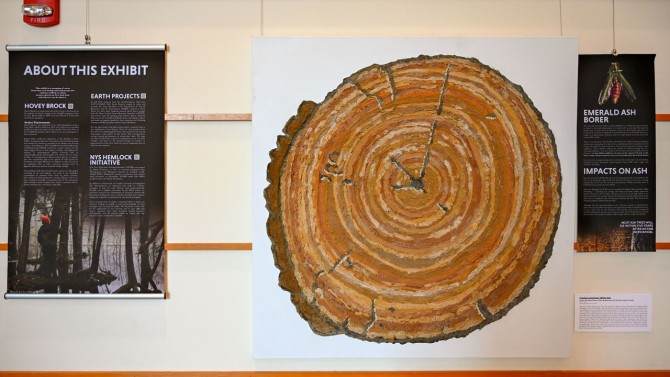Students, scientists, and artists have joined forces to present a Cornell University Library exhibit designed to spread awareness about non-native plants and insects threatening ecosystems in New York state.
Titled "Invasive Species," the exhibit opens Feb. 27 at Mann Library with a talk, "Hemlock Woolly Adelgid and Other Forest Threats: Engaging Science and Art to Meet the Challenge," from 4-5 p.m. in Room 160. A reception in the gallery space will follow.
The New York State Hemlock Initiative, led by forest entomologist Mark Whitmore, contributed scientific text for the displays. Informing and engaging the public is crucial, Whitmore said.
Tree Ring Soil Painting: One of the tree-ring, soil paintings made by students in the Earth Projects class.
"The more people are aware of invasive species and the impacts they have on agriculture and the environment, the more pressure there's going to be on policymakers to put forward proactive measures to stem the flow of invasive species across borders in both directions, all around the world," said Whitmore, a researcher in Cornell's natural resources department specializing in the biological control of the hemlock woolly adelgid, a small aphid-like insect attacking North American hemlock trees.
Invasive insects like the hemlock woolly adelgid have struck close to home for Hovey Brock, an artist who previously sought help from the New York State Hemlock Initiative in protecting trees on his family's land in Claryville, New York, in the Catskills region.
"I'm already seeing the effects of the hemlock woolly adelgid in our valley," he said. "You have these trees that are called 'lollipop' trees because the woolly adelgid is slowly killing off the lower branches, so they lose their needles and you just have this bush at the top."
Hemlocks are a keystone species in the region, Brock said, and their decline will have a devastating impact on the health and biodiversity of local flora and fauna.
In his series of paintings, Brock engages with several invasive plants and insects. He described his abstract paintings as "warnings," or distress signals, featuring statements about climate change that are obscured by colors and textures reminiscent of diseased plants and trees.
Also featured in the exhibit are paintings by students in Earth Projects, an immersive seven-week field course in art and ecology that was designed and taught by multi-media artist Anna Davidson and her graduate teaching assistant, Anna Mehlhorn, M.S. '25.
In the fall of 2023, the students visited Arnot Forest and worked in groups to create paintings depicting cross-sections of trees affected by invasive species. To visualize the fluctuating annual average of temperature and rainfall in New York State as experienced by trees, the students used varying shades of paint that they made from different types of soils at the site.
Combined with scientific facts, artworks can convey knowledge and experience in an urgent, vivid way, said Davidson, a senior research associate in Cornell's natural resources department.
"Art can have an effect on people that the news doesn't," Davidson said. "It can tap into people's emotions and make environmental issues or any issue more frontal, more immediate for our visually oriented society."
The student paintings were exhibited previously in the Soil Factory, an experimental community space in downtown Ithaca. "That was a good closure to the experience for me," said Kiersten Louie '25, one of the participating students. She said that the library exhibit brings the Earth Projects class full circle.
"I feel like this is bringing it back to where we started," said Louie, who is completing a double major in agricultural sciences and environment and sustainability. "I hope that this can be something that people look at and really focus on and absorb the information rather than just walking by."
Running through Aug. 15, the "Invasive Species" exhibit is organized by Cornell's Department of Natural Resources and the Environment, the New York State Hemlock Initiative, and Cornell University Library's Mann Library, with financial support provided by the Elizabeth E. Rowley Fund.
The Cornell University Insect Collection and the Bailey Hortorium also loaned specimens of insects and plants for the exhibit.
Jose Beduya is a staff writer and editor for Cornell University Library.







